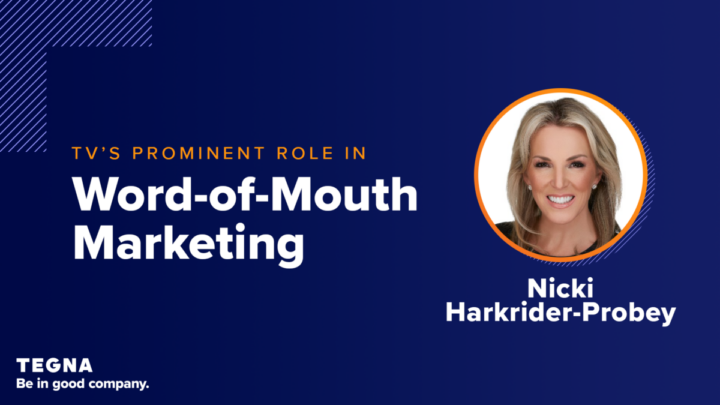February’s Industry News: Total TV Viewership Hits 4-Year High, Super Bowl Ad Recap, Why Are Advertisers Ignoring Boomers? and More
This month’s Industry News series shares the latest articles, insights, and resources curated by Team TEGNA to help your brand stay up-to-date and in the know with all the latest industry happenings. Here’s what came across our desks this month.

Super Bowl Ad Roundup
The Super Bowl remains the pinnacle of advertising, offering brands a unique platform to showcase their creativity and capture the hearts and minds of viewers. As the confetti settles on Super Bowl LIX, we’ve rounded up recaps from across the country on the ads that made us laugh and cry, got us talking, and maybe, just maybe, made us buy.
- Associated Press: Super Bowl was the Most-Watched Program Ever in the US, Averaging 123.7 Million Viewers
- CNBC:Super Bowl 2024 Ads Recap: DoorDash, DunKings, Beyoncé and the Most-Talked-About Commercials
- MediaDailyNews: Television, Search Inseparable During Super Bowl, Google And YouTube Data Shows
- New York Times:$7 Million for 30 Seconds? To Advertisers, the Super Bowl Is Worth It.
- New York Times:No, Michael Cera Is Not the Mastermind Behind CeraVe
- Unilad:Kanye West Spent Millions on ‘Worst’ Super Bowl Commercial Ever
- USA Today Ad Meter: State Farm Commercial Reuniting Arnold Schwarzenegger, Danny DeVito Wins USA TODAY Ad Meter
- USA Today Ad Meter: The Top 10 Super Bowl 58 Commercials
- USA Today Ad Meter: How Much Does a Super Bowl Commercial Cost in 2024? 30-Second Ad Prices Through History
- USA Today: See The 37 Top Super Bowl Commercials Every Year since 1989
More Marketing & Advertising Industry News
AdExchanger: What Do We Say to Emily? The Human Cost Of Advertising Data Abuse
Arielle S. Garcia delves into the disturbing ramifications of data misuse in advertising, particularly within the pharmaceutical industry. She highlights Publicis’ involvement in marketing opioids and raises concerns about the ethical implications of recording doctor-patient conversations for advertising purposes. Garcia emphasizes the real-world harms caused by these practices challenges the advertising industry to prioritize ethics over profit, and calls for accountability from companies, advertisers, and lawmakers alike.
Cord Cutter News: It’s Time to Give Free Services Like Pluto TV, Tubi, the Roku Channel, & Others a Second Chance So They Can Save You Money
As more consumers seek to trim streaming expenses, they’re reconsidering free ad-supported streaming services. While previously dismissed as repositories for outdated and low-quality content, platforms like Pluto TV, Tubi, The Roku Channel, and Freevee have undergone significant transformations and upgraded their offerings through partnerships with major studios to bolster the availability of premium programming. These improvements have elevated the appeal of free ad-supported services, allowing advertisers to explore adding streaming to your media buy lineup.
Fast Company: What We’re Losing in the Blinding Whiteness of Advertising
The dominance of white voices in advertising has shaped industry standards and creative perspectives, prompting them to challenge and diversify representation in their work. This article advocates for a more inclusive approach to creativity in advertising, questioning the assumption that white cultural norms are universally applicable, and urges greater awareness of the racial biases inherent in creative processes.
Forbes: Be Yourself. Everyone Else is Taken. No More Stock Photos in Marketing
Audiences seek more genuine connections with brands, and stock photography and cliche images aren’t the way to create a sense of authenticity, relatability, and differentiation. Showcase your brand’s authenticity by featuring real faces and stories, leaving a lasting impression on investors and setting themselves apart in a competitive market.
MorningStar: Boomers Make up 30% of Consumer Spending. Why do Advertisers Ignore Them?
While baby boomers represent a substantial portion of the population and consumer spending, marketing efforts predominantly target younger generations like Gen Z. Critics argue that when older adults are depicted in ads, they are often portrayed inaccurately, reinforcing stereotypes about technology ineptitude or portraying them in a diminishing light. However, successful marketing campaigns that authentically address the aspirations and needs of older consumers can make a meaningful impact.
S&P Global: Broadcast Outlook 2024: Challenges, Opportunities Facing US TV, Radio Stations
With the rise in sports betting nationally, along with growing interest in Women’s sports (Women’s NCAA basketball title game on ABC through 2032 in a new media rights deal!), and the Taylor Swift effect on the NFL, sports content continues to find new viewers.
Television News Daily: Total TV Viewing Hits 4-Year High In January
Nielsen reported a four-year high in total TV viewing, primarily fueled by a 3.7% increase in streaming activity, with Peacock’s exclusive NFL playoff game streaming on January 13 contributing significantly. Peacock experienced a remarkable 29% surge in streaming performance, reaching a 1.6% share of TV viewing, closely trailing Disney+ and surpassing Tubi. YouTube retained its position as the leading streaming platform, with streaming overall capturing a 36% share of total viewing, while broadcast and cable TV also saw growth.
TV Watch: Rising Online Sports Gambling: What’s The Real TV Viewing Impact?
What is the impact of online sports betting on TV viewing habits, particularly during non-NFL periods? Will it lead to increased TV advertising revenue and viewership, especially for less high-profile games? The NFL’s viewership metrics are used as a benchmark, with analysts noting a rise in viewership, potentially influenced by online betting. These stats suggest a positive outlook for sports leagues in terms of viewer engagement and advertising revenue associated with sports betting.
Yahoo! Finance: Why e.l.f. Beauty’s CFO Sees Marketing as a Growth Center
CFO Mandy Fields attributes the brand’s success to the company’s relevance with young makeup enthusiasts, omnichannel capabilities, and profitable business models. Despite its Gen Z focus, e.l.f. Beauty aims to expand its consumer base to include millennials, Gen Xers, and baby boomers.
Sound Good?
If you like what you’re reading, Team TEGNA would love to talk to you about how we can translate this good news into results for your brand. Let’s get in touch.





















